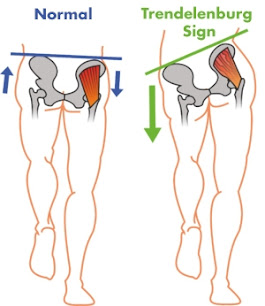Piriformis syndrome
piriformis syndrome is painful musculoskeletal condition; characterized by pain in the buttocks/hip that radiates to back and/or side of the leg due to compression of the sciatic nerve. Synonyms for the condition are Deep gluteal syndrome, extraspinal sciatica and wallet neuritis.
Clinical
anatomy
piriformis muscle
originates from anterior surface of sacrum(s2&s4), gluteal surface of the ilium
(posterior superior iliac spine) and Sacro-tuberous ligament. It passes through
greater sciatic notch to insert onto greater tubercle of the femur. the muscle
is involved in external rotation and abduction of the hip joint. it also
stabilizes head of the femur in the acetabulum.
generally, sciatic nerve exits the pelvic below the belly of the piriformis muscle. still congenital variations are there. According to these variations, Beaton and Anson has classified these relationships into 6 categories
Aetiology
the cause can be divided into two:
1) primary piriformis syndrome: primary piriformis syndrome
includes anatomical causes such as split muscle or split nerve. women are more
prone to the syndrome because of the wider quadriceps angle.
2) secondary piriformis syndrome: this includes precipitating factors such as any microtrauma or macrotrauma to the muscle or local ischemia.
- any type of trauma or sudden jerk might lead to inflammation and spasm of the muscle which might compress the nerve.
- repetitive injury to the muscle might lead to tightening of the muscle
- shortening of the muscle because of altered biomechanics of the lower limb
- SI joint pathology or surgery like total hip replacement
- microtrauma to the muscle by long distance running, walking
- lifting heavy objects
- abnormal spinal alignment(scoliosis)
- limb length discrepancy
- foot problems like Morton’s neuroma
- other causative factors may include horse riding, tennis players, long distance bikes in many cases the cause cannot be identified
Clinical
presentation
Individual with piriformis syndrome may have pain in the low
back that radiates to back/side of the leg, tingling and numbness while
standing, walking, prolong sitting and squatting.
Differential diagnosis
- Trochanteric bursitis
- Herniated intervertebral disc
- Sacroiliac syndrome
- Degenerative disc disease
- Intra articular hip pathologies: labral tear, femuroacetabular impingement
- Spinal canal stenosis
Observation
patient may be present with short limb on affected side (LLD),
gluteal atrophy, pelvic malalignment. Hypertrophy of certain muscles (hyperactive
muscles).
Palpation
On palpation, patient
may have pain in the low back, buttock region, sacroiliac joint. May have
altered sensation down the leg.
Diagnosis
diagnosis is done based on symptoms and physical
examination.
Special
tests
- Straight leg raising: patient feels pain/tingling when examiner raise the leg passively.
- Freiburg sign: patient is in supine position. Examiner internally rotates hip joint to stretch piriformis muscle. Patients get the same symptoms as the nerve is compressed by stretched muscle.
- Trendelenburg sign: may be positive as a result of weak hip abductors (glute med/glute min). patient is asked to stand on one leg. If the opposite side pelvic drops, the test is said to be positive. Side bending in the trunk can be seen as a compensation. We can also observe the sign when patient is walking.
- Hip abduction test: patient is in side lying position. Ask patient to abduct the leg 45 deg. Observe the movement. If patient rotates leg externally; not able to maintain hip neutral, suggests tight piriformis muscle.
- FAIR test: in side lying position, examiner flexes, adducts and internally rotates hip joint passively causing pain in the buttock region.

Physiotherapy
2) Release piriformis muscle
- Therapist may release the tight muscle and surrounding tissue. In prone position, bend the knee of affected leg, and try to move hip in internal rotation while releasing the muscle with elbow.
- Patient can release muscle at home by placing tennis ball under the buttocks region while sitting on the floor. Roll away the ball and notice the trigger points.
 |
| piriformis stretching |
4) hold and relax, muscle energy techniques
5) spine mobilisation/ SI joint mobilisation
- back extension exercise
- static back and static abs exercise
- abdominal strengthening
- knee rolling exercise
- cat-camel exercise
- bridging
- clamshell exercise
- reverse clamshell exercise
- hip abduction exercise (side SLR)
- strengthening of internal rotator of the hip




Very informative 👏👍👌
ReplyDelete